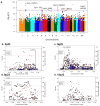Genome-wide association analysis of eosinophilic esophagitis provides insight into the tissue specificity of this allergic disease
- PMID: 25017104
- PMCID: PMC4121957
- DOI: 10.1038/ng.3033
Genome-wide association analysis of eosinophilic esophagitis provides insight into the tissue specificity of this allergic disease
Abstract
Eosinophilic esophagitis (EoE) is a chronic inflammatory disorder associated with allergic hypersensitivity to food. We interrogated >1.5 million genetic variants in EoE cases of European ancestry and subsequently in a multi-site cohort with local and out-of-study control subjects. In addition to replicating association of the 5q22 locus (meta-analysis P=1.9×10(-16)), we identified an association at 2p23 spanning CAPN14 (P=2.5×10(-10)). CAPN14 was specifically expressed in the esophagus, was dynamically upregulated as a function of disease activity and genetic haplotype and after exposure of epithelial cells to interleukin (IL)-13, and was located in an epigenetic hotspot modified by IL-13. Genes neighboring the top 208 EoE-associated sequence variants were enriched for esophageal expression, and multiple loci for allergic sensitization were associated with EoE susceptibility (4.8×10(-2)<P<5.1×10(-11)). We propose a model to explain the tissue-specific nature of EoE that involves the interplay of allergic sensitization with an EoE-specific, IL-13-inducible esophageal response involving CAPN14.
Figures




Comment in
-
Oesophagus. Genome-wide association study reveals the tissue-specific nature of eosinophilic oesophagitis.Nat Rev Gastroenterol Hepatol. 2014 Sep;11(9):518. doi: 10.1038/nrgastro.2014.131. Epub 2014 Jul 29. Nat Rev Gastroenterol Hepatol. 2014. PMID: 25069545 No abstract available.
References
-
- Liacouras CA, et al. Eosinophilic esophagitis: updated consensus recommendations for children and adults. J Allergy Clin Immunol. 2011;128:3–20. e6. quiz 21–2. - PubMed
-
- Putnam PE, Rothenberg ME. Eosinophilic esophagitis: concepts, controversies, and evidence. Curr Gastroenterol Rep. 2009;11:220–5. - PubMed
-
- Abonia JP, Rothenberg ME. Eosinophilic esophagitis: rapidly advancing insights. Annu Rev Med. 2012;63:421–34. - PubMed
Publication types
MeSH terms
Substances
Associated data
- Actions
- dbGaP/PHS000494.V1.P1
Grants and funding
- U01 AI066560/AI/NIAID NIH HHS/United States
- U01 HG006828-S1/HG/NHGRI NIH HHS/United States
- T32 AI060515/AI/NIAID NIH HHS/United States
- P30 DK078392/DK/NIDDK NIH HHS/United States
- UL1 TR-000067/TR/NCATS NIH HHS/United States
- T32 HL7752-19/HL/NHLBI NIH HHS/United States
- T32 HL007752/HL/NHLBI NIH HHS/United States
- UL1 TR-000039/TR/NCATS NIH HHS/United States
- P01 AI083194/AI/NIAID NIH HHS/United States
- UL1 TR-000083/TR/NCATS NIH HHS/United States
- UL1 TR-000424/TR/NCATS NIH HHS/United States
- U01 HG006828-S2/HG/NHGRI NIH HHS/United States
- T32 GM063483/GM/NIGMS NIH HHS/United States
- U01 HG006828/HG/NHGRI NIH HHS/United States
- U19 AI066738/AI/NIAID NIH HHS/United States
- R37 AI024717/AI/NIAID NIH HHS/United States
- UL1 TR000424/TR/NCATS NIH HHS/United States
- UL1 TR000067/TR/NCATS NIH HHS/United States
- UL1 TR001425/TR/NCATS NIH HHS/United States
- I01 BX001834/BX/BLRD VA/United States
- UL1 TR001082/TR/NCATS NIH HHS/United States
- UL1 RR029887/RR/NCRR NIH HHS/United States
- P01 AR049084/AR/NIAMS NIH HHS/United States
- P30 AR047363/AR/NIAMS NIH HHS/United States
- K23 AI099083/AI/NIAID NIH HHS/United States
LinkOut - more resources
Full Text Sources
Other Literature Sources
Medical
Molecular Biology Databases
Miscellaneous

